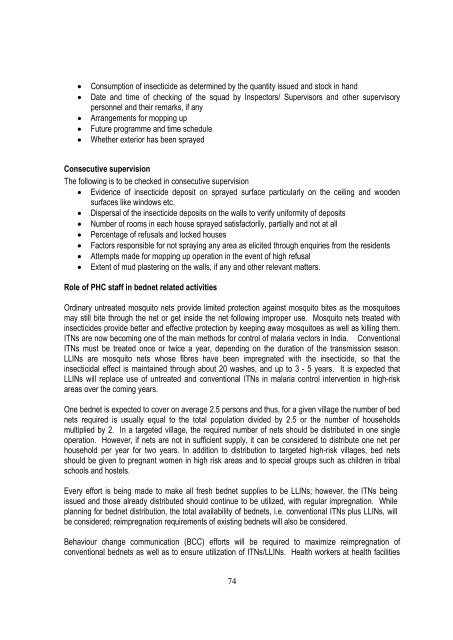training module for medical officers primary health centre - NVBDCP
training module for medical officers primary health centre - NVBDCP
training module for medical officers primary health centre - NVBDCP
- No tags were found...
You also want an ePaper? Increase the reach of your titles
YUMPU automatically turns print PDFs into web optimized ePapers that Google loves.
Consumption of insecticide as determined by the quantity issued and stock in handDate and time of checking of the squad by Inspectors/ Supervisors and other supervisorypersonnel and their remarks, if anyArrangements <strong>for</strong> mopping upFuture programme and time scheduleWhether exterior has been sprayedConsecutive supervisionThe following is to be checked in consecutive supervision Evidence of insecticide deposit on sprayed surface particularly on the ceiling and woodensurfaces like windows etc. Dispersal of the insecticide deposits on the walls to verify uni<strong>for</strong>mity of deposits Number of rooms in each house sprayed satisfactorily, partially and not at all Percentage of refusals and locked houses Factors responsible <strong>for</strong> not spraying any area as elicited through enquiries from the residents Attempts made <strong>for</strong> mopping up operation in the event of high refusal Extent of mud plastering on the walls, if any and other relevant matters.Role of PHC staff in bednet related activitiesOrdinary untreated mosquito nets provide limited protection against mosquito bites as the mosquitoesmay still bite through the net or get inside the net following improper use. Mosquito nets treated withinsecticides provide better and effective protection by keeping away mosquitoes as well as killing them.ITNs are now becoming one of the main methods <strong>for</strong> control of malaria vectors in India. ConventionalITNs must be treated once or twice a year, depending on the duration of the transmission season.LLINs are mosquito nets whose fibres have been impregnated with the insecticide, so that theinsecticidal effect is maintained through about 20 washes, and up to 3 - 5 years. It is expected thatLLINs will replace use of untreated and conventional ITNs in malaria control intervention in high-riskareas over the coming years.One bednet is expected to cover on average 2.5 persons and thus, <strong>for</strong> a given village the number of bednets required is usually equal to the total population divided by 2.5 or the number of householdsmultiplied by 2. In a targeted village, the required number of nets should be distributed in one singleoperation. However, if nets are not in sufficient supply, it can be considered to distribute one net perhousehold per year <strong>for</strong> two years. In addition to distribution to targeted high-risk villages, bed netsshould be given to pregnant women in high risk areas and to special groups such as children in tribalschools and hostels.Every ef<strong>for</strong>t is being made to make all fresh bednet supplies to be LLINs; however, the ITNs beingissued and those already distributed should continue to be utilized, with regular impregnation. Whileplanning <strong>for</strong> bednet distribution, the total availability of bednets, i.e. conventional ITNs plus LLINs, willbe considered; reimpregnation requirements of existing bednets will also be considered.Behaviour change communication (BCC) ef<strong>for</strong>ts will be required to maximize reimpregnation ofconventional bednets as well as to ensure utilization of ITNs/LLINs. Health workers at <strong>health</strong> facilities74
















